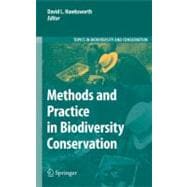
| Annelids, arthropods or molluscs are suitable as surrogate taxa for selecting conservation reserves in estuaries | p. 1 |
| Species' surrogacy for conservation planning: caveats from comparing the response of three arboreal rodents to habitat loss and fragmentation | p. 15 |
| Testing common habitat-based surrogates of invertebrate diversity in a semi-arid rangeland | p. 31 |
| Collembola as bioindicators of restoration in mined sand dunes of Northeastern Brazil | p. 45 |
| An easy-to-use index of ecological integrity for prioritizing freshwater sites and for assessing habitat quality | p. 55 |
| Changes in arthropod diversity along a land use driven gradient of shrub cover in savanna rangelands: identification of suitable indicators | p. 71 |
| Developing a scuba trail vulnerability index (STVI): a case study from a Mediterranean MPA | p. 85 |
| Monitoring large herbivore diversity at different scales: comparing direct and indirect methods | p. 103 |
| A comparison of Australia's anuran records against the reserve system | p. 117 |
| Sustainable biodiversity conservation in the Niger Delta: a practical approach to conservation site selection | p. 131 |
| Rarity and site selection for bryophyte conservation | p. 143 |
| Implications of location specific data and their usefulness in conservation planning: an example from Indian Himalayan Region (IHR) | p. 157 |
| Assessing habitat/landscape predictors of bird diversity in managed deciduous forests: a seasonal and guild-based approach | p. 171 |
| A statistical methodology for tracking long-term change in reporting rates of birds from volunteer-collected presence-absence data | p. 189 |
| Scenario-based assessment of future land use change on butterfly species distributions | p. 213 |
| A model assessing the conservation threats to freshwater turtles of Sub-Saharan Africa predicts urgent need for continental conservation planning | p. 233 |
| Does illegal hunting affect density and behaviour of African grassland birds? A case study on ostrich (Struthio camelus) | p. 245 |
| A rapid and cost-effective tool for managing habitats of the European Natura 2000 network: a case study in the Italian Alps | p. 259 |
| Markov models of territory occupancy: implications for the management and conservation of competing species | p. 273 |
| Estimating historical commercial rock lobster (Jasus edwardsii) catch inside Australian State territorial waters for marine protected area assessment: the binomial likelihood method | p. 287 |
| How bryophytes came out of the cold: successful cryopreservation of threatened species | p. 297 |
| Understanding investment in biodiversity conservation in Mexico | p. 305 |
| Table of Contents provided by Ingram. All Rights Reserved. |
The New copy of this book will include any supplemental materials advertised. Please check the title of the book to determine if it should include any access cards, study guides, lab manuals, CDs, etc.
The Used, Rental and eBook copies of this book are not guaranteed to include any supplemental materials. Typically, only the book itself is included. This is true even if the title states it includes any access cards, study guides, lab manuals, CDs, etc.